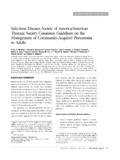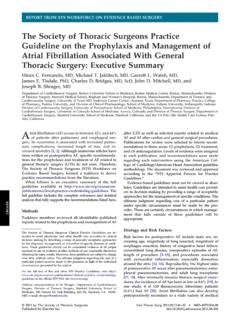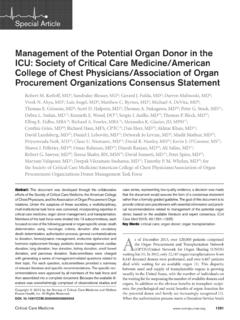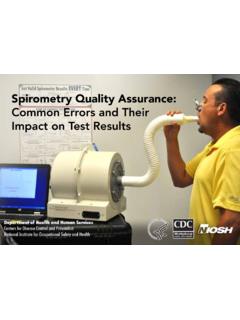Transcription of REVISTA BRASILEIRA DE ANESTESIOLOGIA Official …
1 Rev Bras Anestesiol. 2014;64(1):22---34 REVISTABRASILEIRA DEANESTESIOLOGIAO fficial Publication of the brazilian society of ARTICLEP reoperative evaluation of the patient with pulmonary disease Luiza Helena Degani-Costaa,b, Sonia Maria Faresina, Luiz Fernando dos Reis Falc oa,b, aEscola Paulista de Medicina, Universidade Federal de S o Paulo, S o Paulo, SP, BrazilbMassachusetts General Hospital, Harvard Medical School, MA, USAR eceived 14 September 2012; accepted 19 November 2012 KEYWORDSA nesthesia;Evaluation;Lung;PneumonectomyA bstractBackground and objectives: In daily clinical practice, pulmonary complications related to sur-gical procedure are common, increasing the morbidity and mortality of patients.
2 Assessmentof the risk of pulmonary complications is an important step in the preoperative , we review the most relevant aspects of preoperative assessment of the patient with : Pulmonary risk stratification depends on clinical symptoms and patient s physicalstatus. Age, preexisting respiratory diseases, nutritional status, and continued medical treat-ment are usually more important than additional tests. Pulmonary function tests are of greatrelevance when high abdominal or thoracic procedures are scheduled, particularly when lungresection are : Understanding the perioperative evaluation of the potential risk for developingpulmonary complication allows the medical team to choose the adequate anesthetic techniqueand surgical and clinical care required by each patient, thereby reducing adverse respiratoryoutcomes.
3 2013 Sociedade BRASILEIRA de ANESTESIOLOGIA . Published by Elsevier Editora Ltda. All complication is the occurrence of an unex-pected change that affects the patient s welfare or deviatesfrom the expected outcome after a surgical pulmonary complications (PPCs) occur within Study center: Department of Pulmonology and anesthesiology ,Pain and Intensive Care, Escola Paulista de Medicina --- UniversidadeFederal de S o Paulo. Corresponding : ( dos Reis Falc o).thirty days after the surgical procedure, alter the clinicalpicture of the patient, and may require drug therapy is known that most surgical procedures is relatedto pulmonary function changes,1 --- 3usually mild or moder-ate, but occasionally complications areimportant causes of perioperative ,6It has beenreported in 1%---2% of all patients undergoing minor or mid-size surgery and may reach 10%---20% in those undergoingupper abdominal or thoracic ,6 There are reportsthat acute lung injury (ALI)
4 Occurred in 3% of patients afterelective surgery, a major cause of postoperative $ see front matter 2013 Sociedade BRASILEIRA de ANESTESIOLOGIA . Published by Elsevier Editora Ltda. All rights evaluation of the patient with pulmonary disease 23 Pulmonary complications may be classified according toits potential for death as major (respiratory failure, mechan-ical ventilation and/or intubation for more than 48 h, andpneumonia) or minor (purulent tracheobronchitis, atelecta-sis with clinical and bronchospasm).The achievement of adequate preoperative evaluation ofpulmonary risk allows the institution of measures to reducesuch complications and consequently the perioperative mor-bidity and hospital stay.
5 As a rule, it is recommended thatpatients with previous respiratory disease are evaluated bya predictors were identified for PPCs and arerelated to previous clinical conditions and characteristicsof the anesthetic-surgical procedure. Age over 60 years,pre-existing lung disease, smoking, and previous spiromet-ric changes (FEV1<1 L) are associated with high pulmonaryrisk. Similarly, duration of anesthesia (>3 h), head and necksurgeries, chest and upper abdomen surgeries, and use ofnasogastric tube preoperatively increase the incidence ofrespiratory pulmonary complications are associated withworsening of the postoperative outcome,7in this articlewe will discuss the main clinical factors and strategies inorder to reduce perioperative pulmonary complications ofthe surgical evaluation of the candidate forgeneral surgical proceduresThere are no validated models of pulmonary risk stratifi-cation.
6 We present here a suggestion for initial evaluationbased on the guidelines of the American College ofPhysicians8and on the outpatient experience of preop-erative evaluation of the disciplines of Pneumology andAnesthesiology, Pain and Intensive Care Medicine of theEscola Paulista de Medicina (EPM-Unifesp).All assessment depends crucially on the history andphysical examination, considering the additional tests ret-rospectively, which will be requested in a targeted factors will be discussed in a systematic way aspectsUsually, in surgical procedures with no cavity opening orairway manipulation, the risk for PPCs is low.
7 Intra-cavityprocedures induce major changes in the respiratory systemcompared to peripheral procedures. Thoracic and abdomi-nal surgeries (especially with upper abdomen incisions) arethe non-cardiac procedures with a higher risk of laparoscopic approach may minimizethese changes, but it does not eliminate the risk of surgery has a peculiar risk for PPCs. In myocardialrevascularization, dissection of the internal thoracic arterymay predispose to temporary or perennial phrenic nerveinjury. After cardiopulmonary bypass (CPB), pulmonary dys-function is well described but poorly incidence of acute respiratory distress syndrome (ARDS)after CPB is low (<2%), mortality is high (>50%).
8 12 DuringCPB, both lungs are kept collapsed. If measures are nottaken immediately after the end of CPB, the lungs willbe slowly recruited and more than half of the lungs canremain atelectatic one to two days after surgery, with intra-pulmonary shunt around 20%---30% of cardiac is directly related to the incidence of postopera-tive respiratory complications,14as well as the intensity ofpulmonary interstitial pulmonary changeswith interstitial and alveolar edema may occur when theperiod of CPB exceed 150 surgical time greater than 3 h is an independentrisk factor for the occurrence of postoperative pulmonarycomplications.
9 Emergency surgeries are also associated withhigher incidence of PPCs, as there is no time to stabi-lize the underlying diseases and properly prepare for aspectsGeneral anesthesia is reported in several studies as a riskfactor for PPCs. The use of neuromuscular blocking agentsfor adequate surgical relaxation may be an important causeof respiratory complications and development of postop-erative hypoxemia. This is primarily due to the presenceof residual neuromuscular use of long-termneuromuscular blocking increases this effect by depress-ing the cough reflex and allowing the microaspiration ofgastric exposure to general anesthet-ics may promote changes in gas exchange and temporaryimmunosuppression due to reduced production of surfac-tant, increased alveolar---capillary permeability, impairedalveolar macrophage function, and slow mucociliary general anesthesia, the supine position and inva-sive ventilation promote changes in ventilatory mechanicsbecause it impairs the diaphragm action.
10 Resulting inreduced volumes and lung capacities. As a result, upto 90% of anesthetized patients present with atelectasis,which promote disturbances in ventilation-perfusion (VA/Q),impair lung compliance, and explain the onset of hypox-emia. Persistent atelectasis postoperatively, associatedwith transient respiratory muscle dysfunction and eventualventilation-dependent pain after thoracic and/or abdominalprocedures result in increased work of breathing11(Table 1).In regional anesthesia, the ventilatory effects willdepend on the type and extent of motor blockade. In epidu-ral or subarachnoid extensive anesthesia, with the blockadeof basic thoracic segments, there is a reduction in inspi-ratory capacity and expiratory reserve volume from 20%to 0%.
















